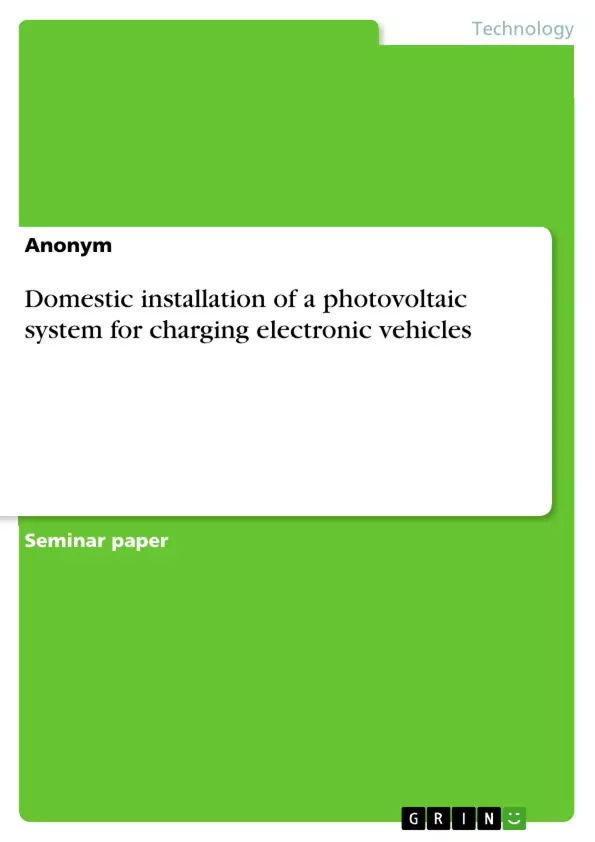At what point is it worth upgrading the electrical installation and purchasing an electric car for everyday use?
This question will arise for many owners - or future owners - of a detached house in the near future. It is not only interesting from an economic point of view, but also from an ecological one.
The following assumptions are made for the scientific work: The electric car is needed for the daily commute from home to work and the extension of the house installation by a photovoltaic system (PVA) complies with the standard of the German Association for Electrical, Electronic & Information Technologies (VDE).
We assume the following scenario for the housework: The detached house is located in northern Germany, the roof is south-facing with the optimum tilt angle of 30° and an average electricity consumption for two adults and two children. The commuting person works during the week, during the day in a company that is 60 kilometres (one way) from home.
This leads to the hypothesis that the monthly petrol costs can be reduced by purchasing an electric car and a PVA. This leads to the following key question:
Is it financially worthwhile to expand the electrical home installation with a photovoltaic system for charging an electric car?
Inhaltsverzeichnis (Table of Contents)
- Introduction
- Terminology
- Extension of the domestic installation
- Existing electrical system
- Installation of a PVA
- Inverter
- Residual current circuit-breaker and miniature circuit-breaker
- Storage of solar power
- Car charging station
- Concepts of energy suppliers and energy consultants
- Provider 1
- Provider 2
- Provider 3
- Provider 4
- Comparison of the concepts
- Cost comparison
- Installation costs
- Variable costs
- Amortisation of the photovoltaic system
- Utilisation and feed-in of the electricity generated
- Petrol costs to be saved
- Cost comparison
- Summary and recommendations for action
Zielsetzung und Themenschwerpunkte (Objectives and Key Themes)
The main objective of this paper is to determine the point at which the expansion of the electrical installation and the purchase of an electric car for daily use will become amortized. This question is relevant for many current and future owners of detached houses. The paper examines this question from both an economic and an ecological perspective, based on the assumption that the electric car will be used for the daily commute and that the installation of the photovoltaic system adheres to VDE standards.
- The financial feasibility of extending the electrical home installation with a photovoltaic system for charging an electric car.
- The technical aspects of integrating a photovoltaic system and a vehicle charging station into an existing electrical installation.
- The cost comparison of different energy suppliers and consultants for photovoltaic system installation.
- The calculation of amortization period for the photovoltaic system based on electricity generation, usage, and fuel cost savings.
- Environmental benefits of reducing fossil fuel dependency through the use of renewable energy and electric vehicles.
Zusammenfassung der Kapitel (Chapter Summaries)
The first chapter introduces the purpose and scope of the research, outlining the question of amortization for electric car and PV system installation. It also defines the hypothetical scenario of a detached house in northern Germany with a specific commuting distance and household size. The chapter ends with the key question of the paper's focus.
The second chapter provides a definition of key terms related to the topic, including standardized domestic electrical installation, photovoltaic system, and electric car. These definitions are referenced from relevant sources to provide a thorough understanding of the technical concepts.
The third chapter details the technical aspects of extending the domestic installation with a PV system. It discusses the existing electrical system, the installation of a PV system, the inverter, the residual current circuit breaker, and the circuit breaker. It also examines the battery storage system and the vehicle charging station.
The fourth chapter explores concepts from different energy suppliers and energy consultants who offer solutions for PV system installation. It presents the approaches of four different providers, highlighting their respective strengths and weaknesses.
The fifth chapter compares the concepts discussed in the previous chapter, focusing on cost analysis and amortization calculations. This includes installation costs, variable costs, and the amortization period for the PV system. The chapter further analyzes the utilization and feed-in of the electricity generated, as well as the fuel costs that can be saved by using an electric car.
Schlüsselwörter (Keywords)
The primary focus of this paper lies in exploring the technical and economic feasibility of extending a standardized domestic electrical installation with a photovoltaic system for charging an electric car. Key terms and concepts include photovoltaic system (PVA), electric vehicle, amortization period, cost comparison, energy suppliers, VDE standards, TN-C and TN-S systems, and the German Renewable Energies Act (EEG).
- Quote paper
- Anonym (Author), 2017, Domestic installation of a photovoltaic system for charging electronic vehicles, Munich, GRIN Verlag, https://www.grin.com/document/1496793



